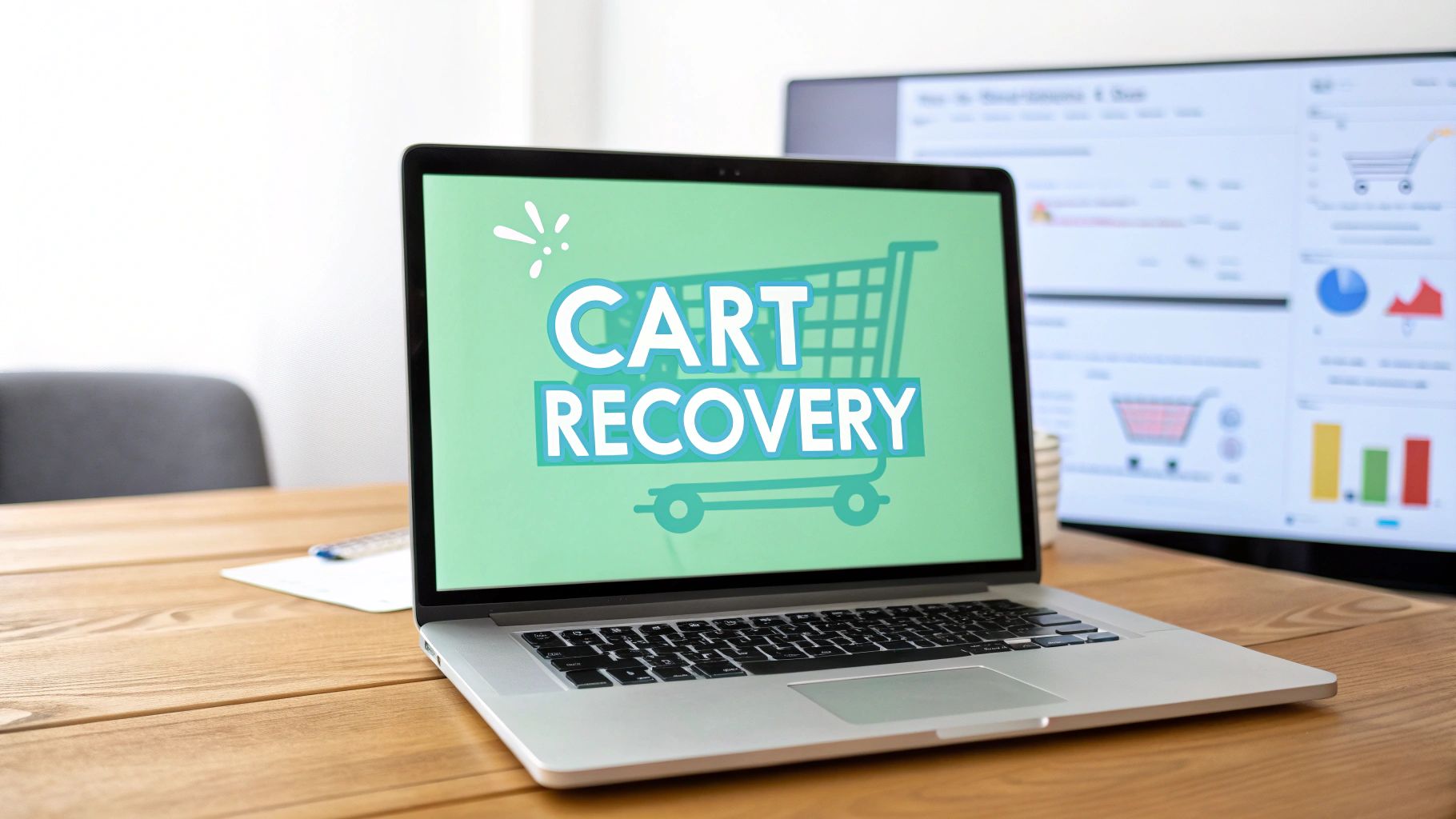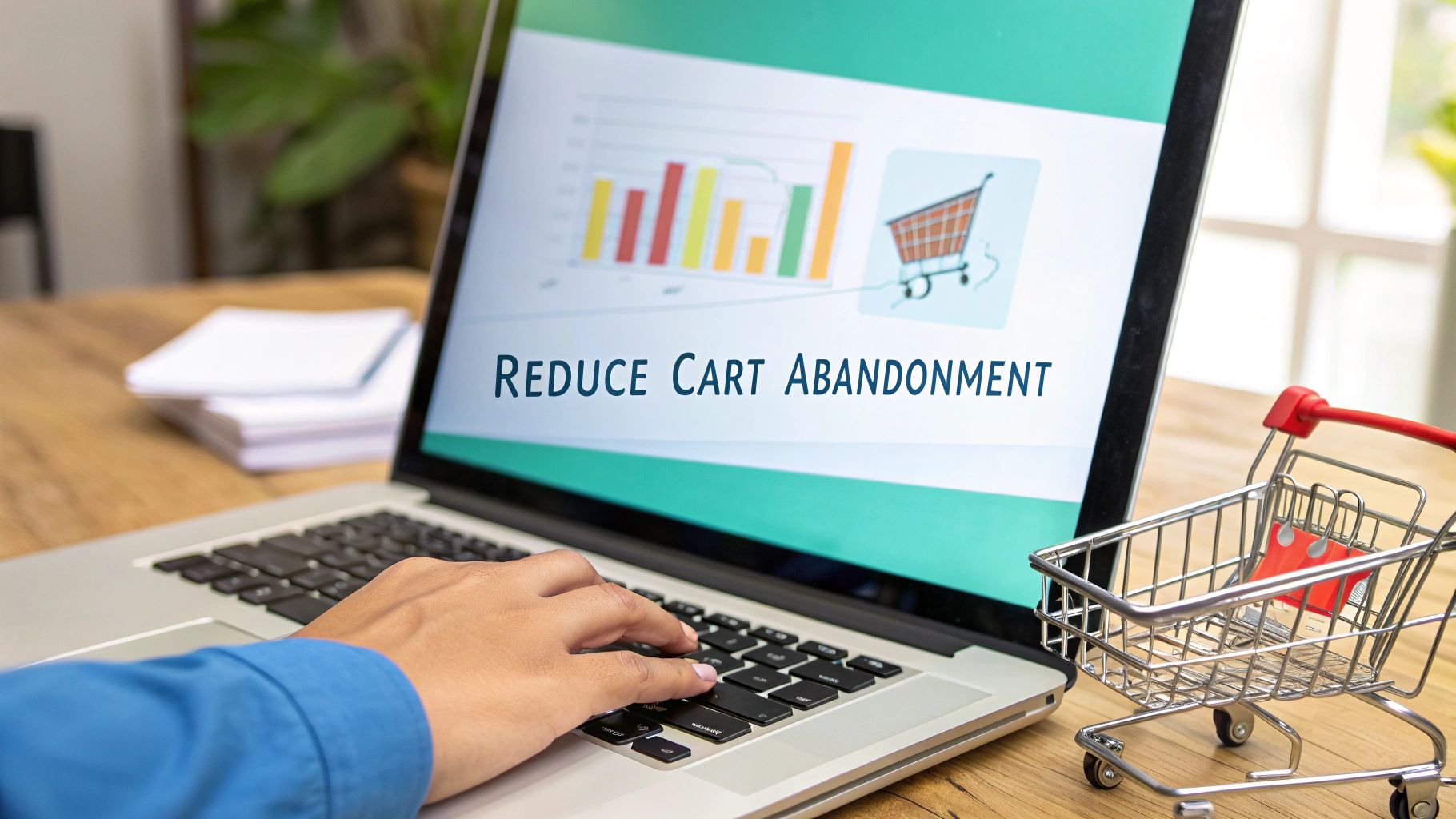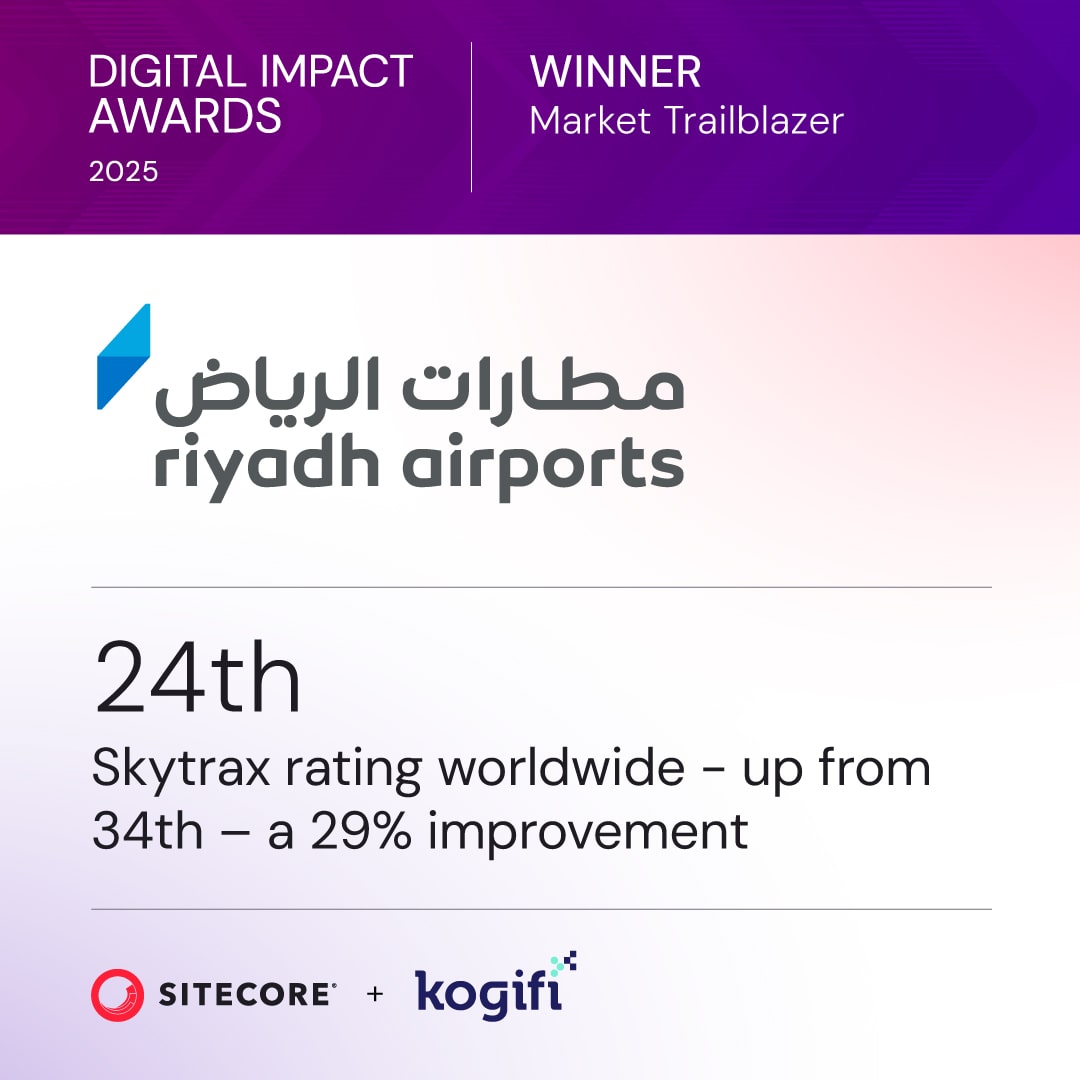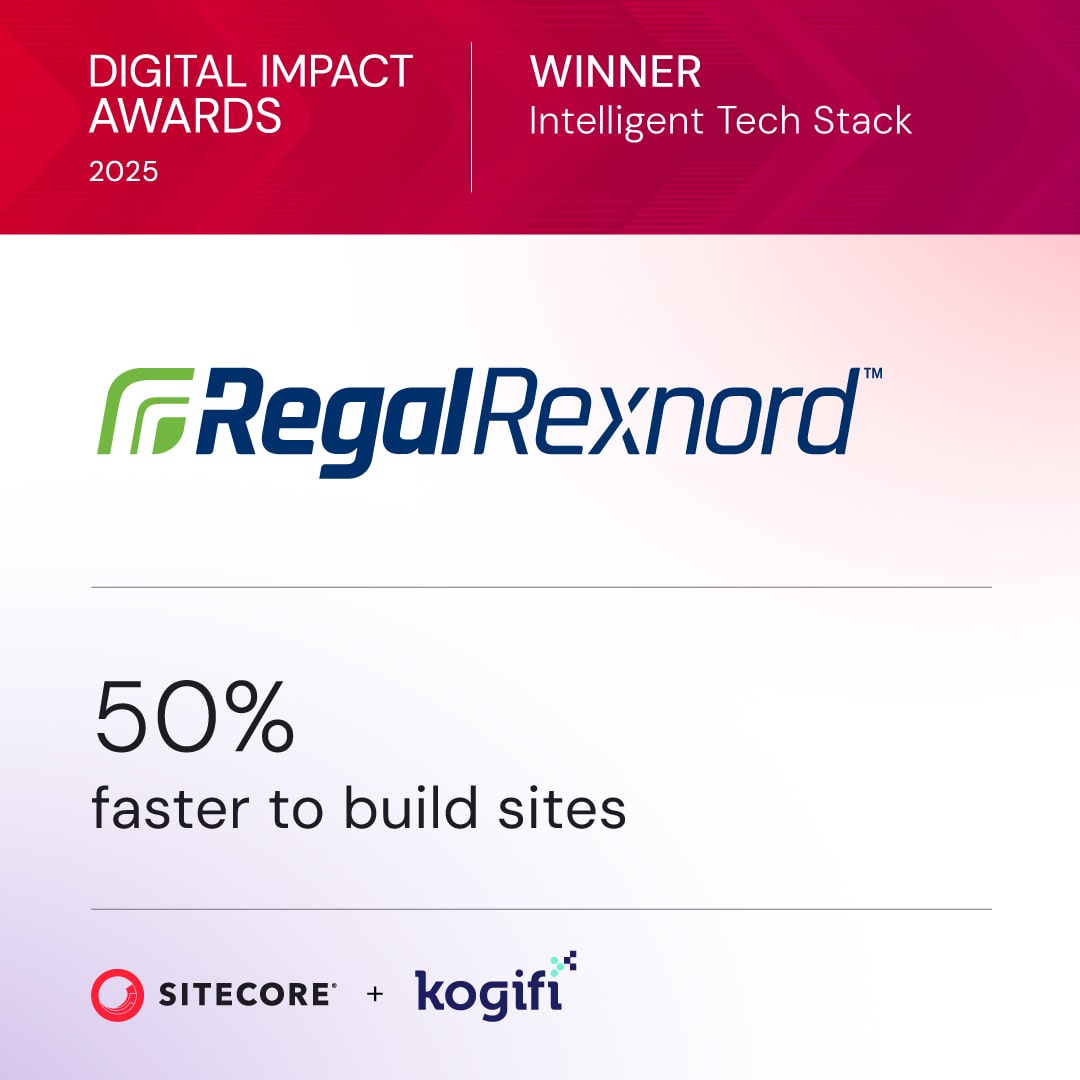Let's get straight to the point: Adobe Experience Manager doesn't have a simple price tag. Think of it less like buying off-the-shelf software and more like commissioning a custom-built headquarters for your entire digital operation. It's a serious enterprise investment, with annual licenses often starting in the six-figure range and climbing significantly from there, all configured specifically for your business needs.
Understanding AEM Pricing: A Direct Overview
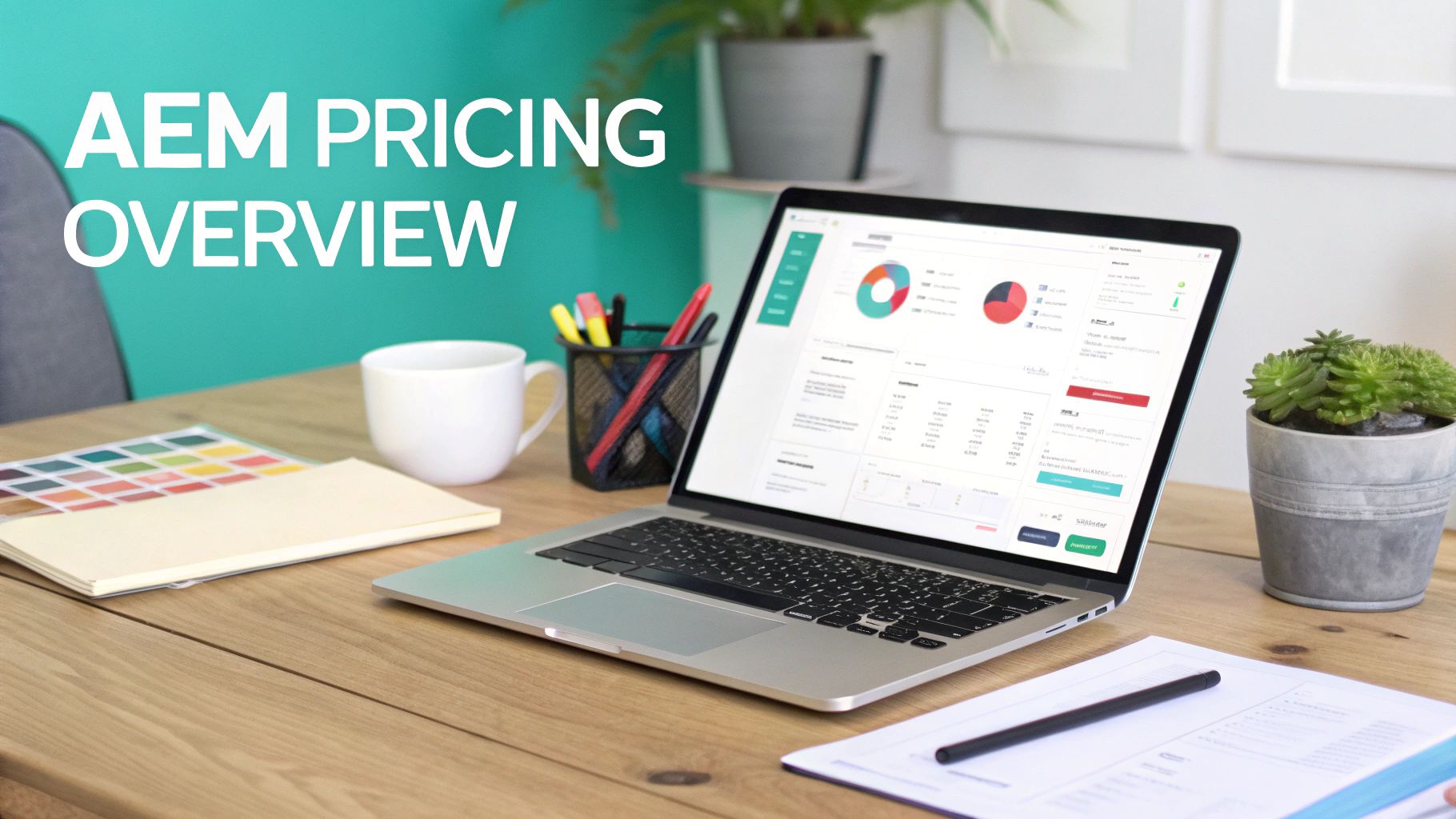
The final number on an AEM quote is a mix of licensing, infrastructure, user counts, and the integrations you need to connect. This overview will give you a high-level summary to help set some realistic expectations. It explains why a one-size-fits-all price just doesn't work for a platform this robust and introduces the key cost drivers we’ll explore throughout this guide.
Our goal here is to give you a clear framework for understanding the total investment. AEM is a powerful foundation for enterprise content management, and its value is often measured against other major players in the Digital Experience Platform (DXP) space.
Why AEM Pricing Is Variable
Unlike simpler platforms, AEM is built from the ground up for complexity and scale. Organizations coming from systems like SharePoint often find the pricing structure fundamentally different. Where SharePoint solutions might be bundled into broader Microsoft 365 licenses, AEM's cost is directly tied to its specific capabilities and how much you use them.
If you're familiar with the Sitecore ecosystem, you'll recognize the modular, enterprise-focused approach. Just as Sitecore’s pricing scales with features like XM Cloud, OrderCloud, or Personalize, AEM's cost is built around its core components and your consumption levels.
The core idea behind AEM pricing is value-based. The investment is designed to match the scale of the digital experiences you deliver, the sheer volume of assets you manage, and the global reach of your operations.
Key Factors Influencing Your AEM Investment
Before you can even begin to build a budget, you need a solid grasp of the variables that shape the total cost of ownership. These aren't just line items on a quote; they represent the operational scope of your entire digital strategy.
The table below breaks down the main components that will determine your final investment.
Each of these elements plays a crucial role in shaping your AEM license and the ongoing costs associated with running the platform.
Understanding these components is the first step toward accurately forecasting your budget. For a deeper dive into the platform's capabilities, you can learn more about our Adobe Experience Manager services and how they align with business goals.
Breaking Down the Core Cost of AEM Licensing
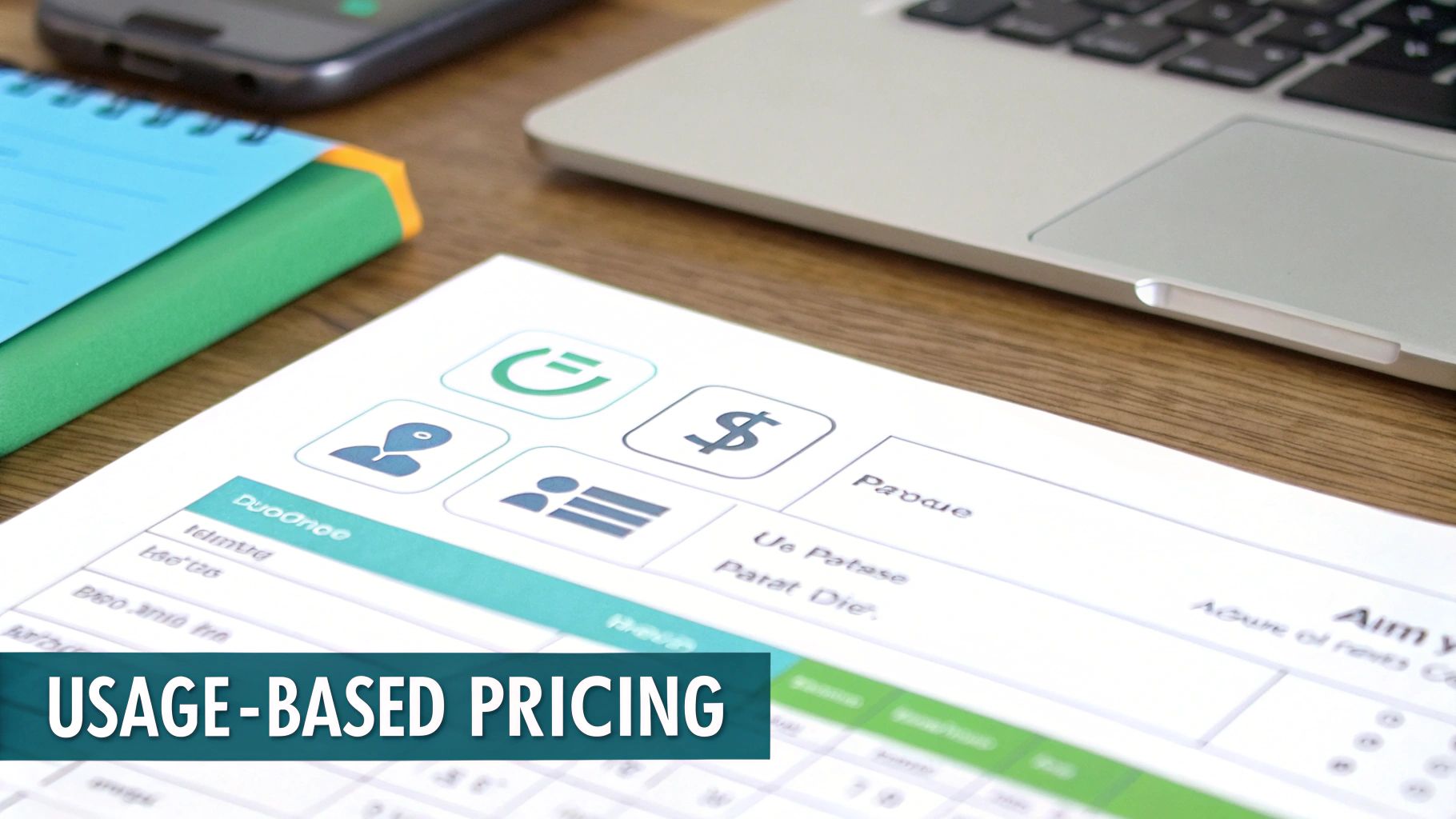
Before you can even start to build a budget for Adobe Experience Manager, you have to get your head around its licensing. Adobe has almost completely moved to a modern subscription model called AEM as a Cloud Service (AEMaaCS). This isn't just an Adobe thing; it's a massive industry shift away from huge, upfront capital expenses (CapEx) toward more predictable operational spending (OpEx).
Think of your AEMaaCS license like the utility bill for a factory. You don't just pay a flat rate to keep the lights on. Your bill goes up or down based on how much power you're actually using. This usage-based approach is why Adobe doesn't have a public price list—every single company's consumption is different.
The Key Metrics That Drive Your AEM Subscription
To figure out your potential AEM costs, you first need to understand what "usage" actually means to Adobe. Your final price is directly tied to the scale of your digital operations, and it all boils down to a few core metrics:
- CDN Traffic and I/O: This is all about how many page views, API calls, and data transfers your websites and apps are handling. A high-traffic global site is going to have a much higher consumption rate than a small regional one.
- Storage Volume: How much space are you taking up? This is a big one for companies with massive libraries of high-resolution images, videos, 3D models, and other digital assets.
- User Seats: Pretty straightforward—how many authors, editors, administrators, and developers need to log in and work inside the AEM authoring environment?
- Performance Tiers: This is the horsepower. It’s the raw computational power allocated to your environment, determining how well it handles traffic spikes and complex tasks.
This model is a world away from the old on-premise licensing days. Back then, you’d pay a massive one-time fee for a perpetual license, but then you were on the hook for unpredictable costs for hosting, maintenance, and painful manual upgrades.
How AEM Modules Impact the Price Tag
AEM isn't a single product; it's a powerful suite of different tools, or modules. The specific solutions you choose to license will have the biggest impact on your final bill. A simple implementation of AEM Sites for web content will have a completely different price point than a full-blown deployment that also includes AEM Assets for enterprise-wide digital asset management.
This modular approach might feel a bit different if you're coming from a platform like SharePoint, where capabilities are often bundled into a broader Microsoft 365 agreement. AEM forces you to be more deliberate, selecting and paying only for the specific functions you need.
It's actually much closer to the Sitecore DXP model. Just as licensing Sitecore XM Cloud is a separate decision from adding Sitecore Personalize or OrderCloud, your total AEM cost is built by combining components like AEM Sites, AEM Assets, and AEM Forms.
The key takeaway here is that you're not just buying software. You're subscribing to a specific level of digital capability. The more you need AEM to do—power global sites, serve millions of assets, personalize customer journeys—the higher that subscription will be.
This structure reflects AEM's position as a true enterprise-grade platform. Let's be frank: Adobe Experience Manager pricing is known for being high. Licensing fees can easily run from tens of thousands to several hundred thousand dollars a year. The final number depends heavily on your user count, asset volume, and which modules you need. Some larger AEMaaCS setups can even cost upwards of $5,000 per user per month.
For a deeper dive into how AEM's cost compares to other major platforms, check out our comprehensive analysis of AEM vs. Sitecore.
Once you have a handle on AEM's licensing, it's smart to explore broader strategies for optimizing software licenses to make sure you're getting the most value from your investment. Because that substantial licensing fee? It's just the starting point of the total financial picture.
Uncovering the Hidden Costs Beyond the AEM License

Fixating on the AEM license fee is a classic budgeting mistake. That initial quote is a huge part of your investment, no doubt, but it’s nowhere near the full story. The real total cost of ownership (TCO) is much bigger, filled with critical expenses that can easily catch unprepared teams by surprise.
These aren't "hidden" costs in a deceptive sense; they're just the natural result of implementing a platform of this scale. Think of your AEM license as the engine for a high-performance race car. It's essential, but you still need to buy the chassis, hire a skilled driver, pay for a pit crew, and keep the tank full of fuel if you actually want to win the race.
Getting a firm grip on these additional costs is the only way to build a realistic, sustainable budget for your AEM investment.
Implementation and Customization: The Heavy Lifting
The first major cost you’ll run into after signing for the license is implementation. AEM isn't something you just turn on. It demands expert configuration to make it work with your specific business processes, content structures, and internal workflows.
This setup phase is a massive undertaking, almost always requiring a specialized partner to get it done right. If your team is coming from a platform like SharePoint, you'll find the process is on another level. While you might be able to configure SharePoint internally, AEM's power can only be unlocked by a dedicated team building out custom components, templates, and the backend logic you need.
The cost of implementation often lands somewhere between 50% to 200% of your first-year license fee. This isn't just setup—it's about transforming a powerful but generic platform into a tool that solves your unique business problems.
A huge chunk of that customization cost comes from integrating AEM with the rest of your tech stack. Connecting it cleanly to your CRM, ERP, or e-commerce platform is non-negotiable for creating the unified customer experiences AEM is famous for.
Content Migration: Your Digital Relocation
Another expense that teams consistently underestimate is content migration. All your existing content—whether it’s on an old CMS like an outdated SharePoint or a platform like Sitecore—has to be moved into AEM. This is rarely a simple copy-and-paste job.
The process involves a few key steps:
- Content Auditing: Sifting through everything to decide what to move, what to archive, and what to leave behind.
- Content Mapping: Figuring out how your old content structure fits into the new AEM content models and components.
- Scripting and Automation: Building scripts to efficiently move thousands, or even millions, of pages and assets.
- Manual Cleanup: Inevitably, there will be exceptions and edge cases that automated tools can't handle, requiring manual work.
The complexity here depends entirely on the volume and structure of your source content. A well-organized Sitecore instance will be a different migration challenge than a sprawling, unstructured SharePoint farm. It’s absolutely critical to scope this accurately from day one.
Ongoing Maintenance and Support
Your spending doesn’t stop once AEM is live. With AEM as a Cloud Service, Adobe takes care of the core platform updates, but you're still on the hook for your custom code and integrations. That means you need a solid plan for ongoing maintenance and support.
This includes everything from fixing bugs and monitoring performance to applying security patches to your custom code and making small tweaks to meet new business needs. For most companies, this means either keeping your implementation partner on retainer or building out a dedicated internal AEM team. Managing these systems is a specialized skill, and a strong support plan is essential for a business-critical platform. You can learn more about what goes into professional AEM support and hosting services to get a better idea.
Finally, don't forget the people. Team training is crucial. Your content authors, marketers, and developers all need to learn how to use the new system effectively. Investing in training is what ensures you actually get the value out of the powerful new platform you just paid for.
Calculating the Real ROI of Your AEM Investment
Once you’ve mapped out the licensing, implementation, and maintenance costs, the conversation naturally shifts from expense to value. A premium platform like Adobe Experience Manager comes with a significant price tag, so how does it actually pay for itself?
The answer lies in looking beyond the initial budget and focusing on the real, measurable business impact. Justifying adobe experience manager pricing requires drawing a clear line from the platform's features to tangible outcomes. This isn't just about getting a better CMS; it's about driving revenue, creating massive efficiencies, and building a solid foundation for future growth.
Driving Revenue with Advanced Personalization
One of the biggest ROI drivers in AEM is its power to deliver deeply personalized customer experiences at scale. In today's market, generic, one-size-fits-all content just doesn't cut it anymore. AEM lets you move past basic segmentation to create 1:1 interactions that directly influence customer behavior and boost lifetime value.
For organizations used to the more generalized content delivery of SharePoint, this capability is a complete game-changer. While SharePoint is great for internal collaboration, it just doesn't have the sophisticated personalization engine needed to win over external customers. AEM's tools let you target users based on their behavior, demographics, and real-time context, which in turn increases conversion rates and average order value.
This focus on experience-driven commerce is a philosophy shared by platforms like Sitecore. Both AEM and Sitecore are built on the idea that personalization isn't just a feature—it's a core driver of revenue. Leveraging Sitecore Personalize or AEM's equivalent tools justifies the investment through proven ability to lift key business metrics.
Gaining Operational Efficiency Through Content Velocity
Beyond direct revenue, AEM delivers a huge return by streamlining global marketing operations. For large enterprises, the process of creating, approving, and publishing content across dozens of regions and languages can be a massive bottleneck, draining both time and resources.
AEM is engineered to solve this exact problem. Its powerful workflow automation, content fragment models, and translation management tools create what’s known as content velocity—the speed at which you can get high-quality content out the door and in front of customers.
- Centralized Asset Management: AEM Assets acts as a single source of truth, finally putting an end to the wasted time and version-control chaos that plagues decentralized systems. This is comparable to the enterprise-level control offered by Sitecore Content Hub.
- Component Reusability: Marketers can build and launch new pages and campaigns without constantly needing a developer, which dramatically cuts down production timelines.
- Streamlined Workflows: Automated approval chains ensure content moves from creation to publication efficiently and with full governance in place.
These efficiencies translate directly into cost savings. Teams spend less time bogged down in manual, repetitive tasks and more time on high-value, strategic work. This operational lift is a critical piece of the platform's overall value.
The total economic impact of Adobe Experience Manager demonstrates substantial financial benefits. An IDC-style three-year analysis of a composite organization using Adobe Experience Cloud, which includes AEM, revealed benefits with a present value (PV) of $35.1 million against total costs PV of $10.3 million. This resulted in a net present value (NPV) of $24.8 million and an impressive ROI of 242%, with a rapid seven-month payback period. You can explore the complete analysis of Adobe's economic impact in this detailed report.
This table gives a sample breakdown of where those ROI figures might come from for a typical large organization over three years.
AEM ROI Breakdown Sample Three-Year Financial Impact
This example shows how the benefits aren't just theoretical; they add up to a significant financial impact that far outweighs the initial investment.
Building a Compelling Business Case
Ultimately, calculating the real ROI of an AEM investment means connecting the dots between its advanced features and your specific business goals. You need to quantify the expected gains in revenue, the cost savings from operational improvements, and the strategic advantage of having a digital foundation that can scale with you.
Framing the discussion around these tangible business outcomes is the key to building a compelling internal case that gets the green light. To help you structure this analysis, a great starting point is our DXP ROI calculator, which provides a framework for measuring the financial impact of your digital initiatives.
Placing AEM in the Digital Experience Ecosystem
To really get your head around Adobe Experience Manager pricing, you have to stop thinking of it as just another content management system. AEM’s true value—and the reason behind its premium price tag—is its role as the central nervous system for your entire digital experience ecosystem. It's an investment in a rock-solid foundation for your whole digital strategy, not just a tool for building web pages.
The platform's power really shines when you start connecting it with other products in the Adobe Experience Cloud. Pair AEM with Adobe Analytics and Adobe Target, for example, and you've suddenly created a powerful feedback loop for crafting data-driven customer journeys. This trio lets you serve up personalized content from AEM, measure its impact with Analytics, and then fine-tune it with Target.
Beyond a CMS: A Platform Perspective
Lumping AEM in with a standalone CMS or a basic collaboration tool like SharePoint completely misses the mark. SharePoint is great for internal document sharing and team sites, but it was never built to power personalized, global, customer-facing experiences. AEM, on the other hand, was designed from the ground up for that exact job.
This ecosystem-first mindset is much closer to the philosophy behind platforms like the Sitecore DXP. Any seasoned Sitecore architect will tell you that the value of XM Cloud skyrockets when you integrate it with Sitecore Personalize, CDP, and OrderCloud. It's that combination of specialized tools that creates a unified powerhouse. AEM’s pricing reflects the same principle: it’s built to be the content engine for a much wider array of marketing and analytics tools.
You are not just buying a piece of software; you are investing in a platform that unifies content, data, and delivery. This integrated power is what separates enterprise DXPs from standard content management systems.
The Power of Community and Integrations
AEM’s premium standing is also backed by a massive community of partners and developers. A platform is only as strong as its ability to connect with the other critical systems that run your business—from CRMs to e-commerce engines—so having strong system integration strategies is non-negotiable.
Adobe’s pricing reflects its position as a top-tier platform for global enterprises, but they also offer configurable packages, like Experience Manager Assets with Prime and Ultimate tiers, to fit different needs. The real muscle, though, comes from the ecosystem: with over 4,000 active solution partners and 460,000 developers, you’re tapping into a constant stream of innovation. This makes even the most complex integrations simpler and helps you get the most out of your investment. You can see a breakdown of how this works in this Adobe core components overview.
This vast network means you’re never going it alone. Whether you need a niche integration, a custom component, or expert support, there’s a global community of specialists ready to jump in. That level of support acts as a safety net, justifying the higher cost by ensuring the platform can grow with your business and serve as a future-proof foundation for years to come.
Your Guide to Scoping an Accurate AEM Budget
Feeling overwhelmed by all the variables that go into Adobe Experience Manager pricing? You're not alone. Scoping a platform this massive is a big undertaking, but it doesn’t have to be a guessing game. This section breaks it all down into a practical, step-by-step checklist to help you nail down your requirements and get a realistic price estimate—before you even talk to Adobe or a partner.
Think of this as a structured framework that turns a complex challenge into a series of manageable steps. By getting these key questions answered upfront, you'll walk into the procurement process with confidence, knowing the final quote will actually match what you need.
The diagram below gives you a high-level look at the AEM adoption journey, from the core platform license to integration and long-term support.
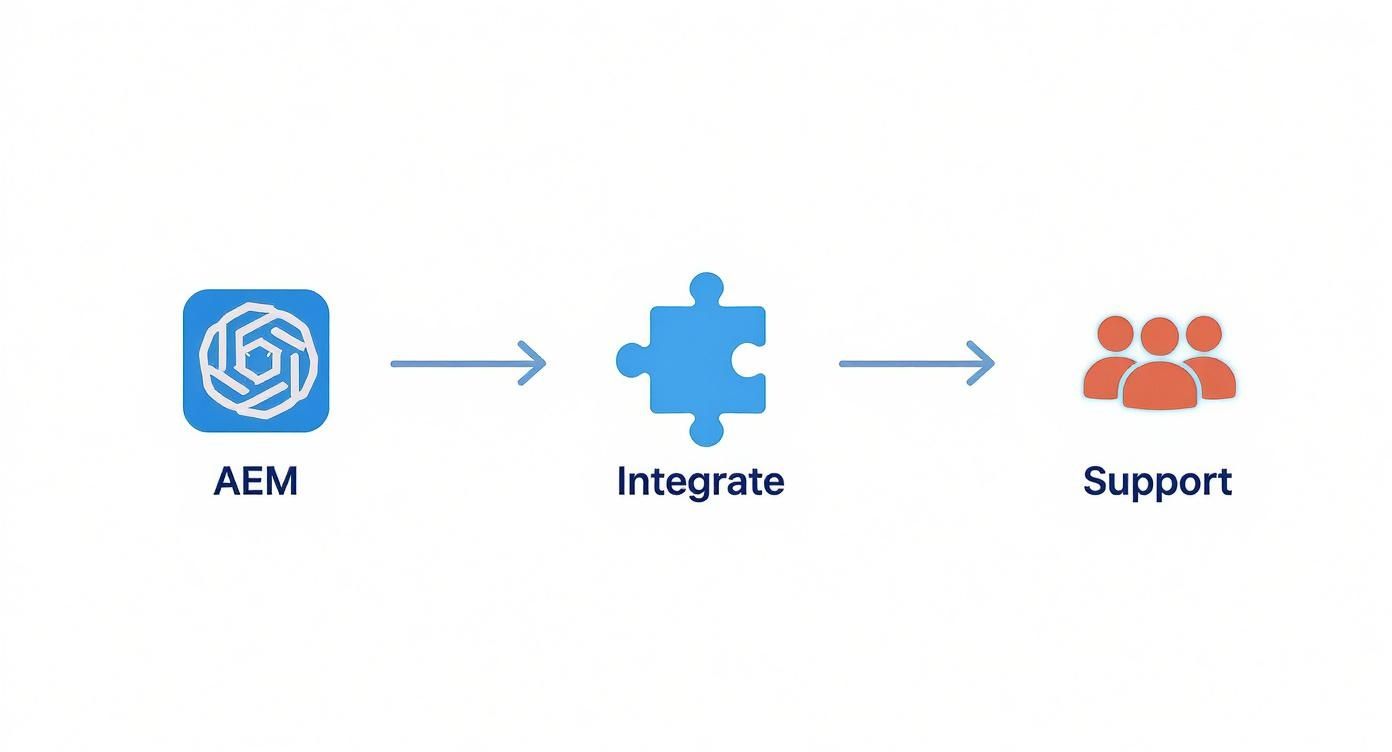
As you can see, the initial platform is just the starting point. The real power—and value—comes from wiring it into your existing tech stack and having a solid support plan in place.
Your Pre-Procurement Checklist
Before you even think about engaging with vendors, do yourself a favor and gather this information. Getting prepared will make those conversations smoother and lead to a much more accurate initial quote. It’s like creating a blueprint for your digital operations.
1. Define Your User Base
First things first: map out every single person who will need access to the AEM authoring environment. This is more than just a headcount; it’s about understanding their roles and what they’ll be doing.
- Content Authors: How many marketers or content creators will be in the system daily, building pages and adding content?
- Editors & Approvers: Who’s on the hook for reviewing, editing, and giving the final sign-off before content goes live?
- Administrators & Developers: How many technical folks need backend access for maintenance, troubleshooting, and new development?
Unlike a platform like SharePoint, where access might be tied to a broad company license, AEM user seats are a direct and specific cost. Get as precise as you can.
2. Estimate Your Digital Asset Needs
AEM Assets is one of the platform's biggest strengths, but that power comes with a cost tied directly to storage. If you’re moving assets over from a system like Sitecore Content Hub or even just a chaotic collection of network drives, you need a solid estimate.
- Current Storage: What’s the total size (in gigabytes or terabytes) of all the images, videos, PDFs, and other files you plan to bring into AEM?
- Projected Growth: Try to estimate how much your asset library will grow over the next three years. A 20-30% annual growth is a safe bet for most active marketing teams.
3. List Critical Third-Party Integrations
AEM rarely works in isolation. In fact, its power multiplies when it’s connected to your other critical business systems. Make a definitive list of your must-have integrations.
- CRM System: Are you connecting to Salesforce, Microsoft Dynamics, or something else?
- Marketing Automation: Will it be Marketo, HubSpot, or another platform?
- E-commerce Platform: Is it Adobe Commerce (Magento), Sitecore OrderCloud, or a custom solution?
- Analytics Tools: Will you use Adobe Analytics, Google Analytics, or both?
Each integration adds another layer of complexity to the implementation, which means more time and money. Prioritizing this list is key.
4. Map Your Global Content Requirements
Finally, outline your global footprint. AEM is brilliant at managing content for multinational companies, but this capability directly impacts the performance tier you'll need.
- Number of Websites: How many distinct sites will you be managing from a single AEM instance?
- Number of Languages: How many languages do you need to support for translation and localization workflows?
- Geographic Regions: Are you serving content to audiences in North America, EMEA, APAC, or all of the above?
With these details buttoned up, you're ready to have a productive, data-driven conversation about Adobe Experience Manager pricing.
Alright, let's wrap this up by tackling some of the questions that always come up when companies start looking into Adobe Experience Manager. Getting straight answers here can clear up a lot of confusion and help your team set realistic expectations from the get-go.
How Does AEM Compare to Sitecore or SharePoint?
This is probably the most common question, and for good reason. While all three platforms manage content, they play in completely different leagues and come with very different price tags.
SharePoint is best thought of as an internal collaboration tool. It's often already part of a bigger Microsoft 365 enterprise deal. It’s fantastic for intranets and document management, but it was never built for the kind of sophisticated, customer-facing digital experiences AEM handles. Comparing them on price is like comparing apples and oranges.
Sitecore is AEM’s true rival in the enterprise DXP space. Just like AEM, Sitecore’s pricing is modular—you pay for the specific tools you need, whether it's XM Cloud, OrderCloud, or their CDP. Both platforms justify their premium price by delivering serious power in personalization, scalability, and content operations. They’re value-based investments, not just software you buy off the shelf.
Ultimately, the AEM vs. Sitecore decision often boils down to your company's existing tech stack and long-term goals. Are you already invested in the Adobe Experience Cloud? Or does Sitecore's composable DXP philosophy feel like a better fit for where you're headed?
Is There a Small Business Version of AEM?
In short, no. Adobe Experience Manager is built from the ground up for the enterprise market. Its architecture, feature set, and pricing model are all designed to solve the complex problems that large, global organizations face.
You won't find an "AEM Lite" because the platform's core value lies in its massive scalability, ironclad security, and deep integration capabilities—all things that address enterprise-level challenges. A mid-market company would likely find the cost too high and the features far beyond what they actually need.
Can We Negotiate the AEM License Price?
Absolutely. Negotiation is a normal and expected part of any enterprise software deal. The final number on the contract isn't set in stone and can shift based on a few key factors:
- Total Contract Value: The bigger your overall deal with Adobe (including other Experience Cloud products), the more room there is to negotiate.
- Contract Length: Committing to a longer-term partnership, like a three-year deal instead of one, can often unlock better annual pricing.
- Competitive Landscape: If you have a strong, compelling proposal from a competitor like Sitecore, you'll have much more leverage at the negotiating table.
This is where working with an experienced implementation partner can give you a real edge. They’ve been through this process countless times and can help you benchmark your quote against similar deals, ensuring you get the best possible terms.
Navigating the world of DXP procurement takes serious expertise. The team at Kogifi has spent years helping enterprises scope, implement, and optimize platforms like AEM, Sitecore, and SharePoint to get the most out of their digital investment. https://www.kogifi.com






















